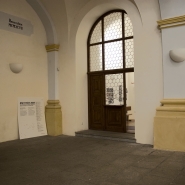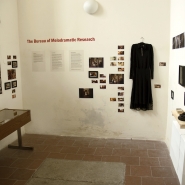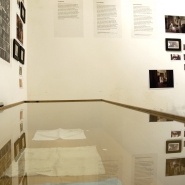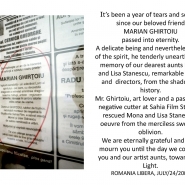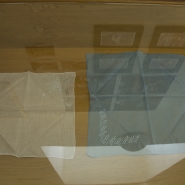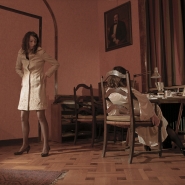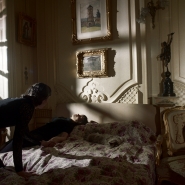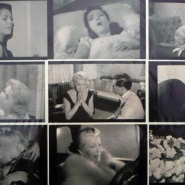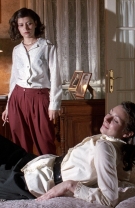
Irina Gheorghe & Alina Popa
ROM
The artist’s photographic conceptual piece, whose main protagonists are the artist herself, involves an intricate mystification. The work contains several layers of meaning, with references to the history of Romania after World War II (a Hollywood-influence film industry, communist censorship, the nationalization of the buildings in which Romanian films were made). It also engages in contemporary feminist discourse.
Marcel Fišer
.
.
The Bureau of Melodramatic Research
The beginning
The mention of a private archive containing 35 mm footage in Mr. Ghirtoiu’s obituary, recently published in a local newspaper, has revealed the roots of a yet unknown women’s movement involved in producing independent films in Romania during the 40’s.
The two initiators, Mona and Lisa Stanescu, were also playing the lead roles of these lost films, which stylistically mimic Hollywood classic melodrama and film noir. However, the backdrop seems to be real, diverting the artificial studio system of the American model through a keen touch of documentary. A collection of film stills exclusively featuring the two women has been preserved, but couldn’t be exactly dated due to lack of information. Or so it seemed at that point in time.
Current situation
Subsequent research has shed some light on the unfolding of this story: it appears that a certain Mr. Ghirtoiu has only accidentally come into possession of the archive by moving into a nationalized house in the early 50’s1, where one of the films had actually been shot. This Mr. Ghirtoiu was at the time working at the Bureau for the Destruction of Forbidden Films, in a small department in charge of removing censored sequences. Still, the facts should be understood as intended. Ideologically faithful to his job, he nevertheless cut off the fragments in which the two appeared and carefully stored them, destroying the rest according to his beliefs.
Some say Mona and Lisa Stanescu were actually playing the masquerade of femininity. What if they were even aware of Joan Rivière’s 1929 essay Womanliness as a Masquerade? Before the question was answered, the ones concerned have already spotted the irony behind the story: it is exactly the masculine gaze2 they were mocking that saved the films from forever sinking into oblivion. Moreover, The Manifesto of the Melodramatic Woman, a document of utmost importance, was found among other notes and personal objects, which we forgot to mention above.
Further developments
A Bureau of Melodramatic Research has been established to investigate these independent productions which have been melodramatically recuperated. The Bureau will invite experts from various fields to discuss whether such material is worth reviving, the ambiguous historical placement and political position of the movement and possible ways of manipulating its significance in the present.
Key elements in the research are the rise of the melodramatic woman and the constant peril of her emotional-octopus tactics that could gradually exhaust the powers of the patriarchal structures and undermine high / cold / masculine culture. Will this be the end?
Another matter of speculation will be the presumably inverted critique practiced by Mona and Lisa Stanescu, echoing psychoanalytic and feminist writings of the previous decades3, as well as its infiltrations in today’s social consciousness.
The Bureau will conduct critical analysis both by pursuing its melodramatic methodology defined as melocritique and by detecting melodramatized versions of personal / collective history in the media.
If you feel you can be of any help, please do not hesitate to contact us.
-AP, IG -
1 In 1948 the entire private property in Romania was nationalized.
2 The very concept of male gaze would be later theorized by Laura Mulvey in Visual Pleasure and Narrative Cinema (1975).
3 Besides the alleged connection to Joan Rivière’s Womanliness as a masquerade (1929), the directors acknowledge their influence from Claude Cahun’s writings, notably Les Héroïnes (1925).
*1981, ROM
IRINA GHEORGHE
Born in 1981 in Tirgoviste, RO. Lives and works in Bucharest
Education
2007-2009 MA in Photography, Universitatea Nationala de Arte, Bucharest
2003-2007 Painting Department, Universitatea Nationala de Arte, Bucharest
Solo Exhibitions
2008 Poto& Cabengo (work in progress), Galeria UNA, Bucharest (with Alina Popa)
2007 Steluta and Neluta. Memories from that Year’s Summer, Galeria UNA (Long Night of the Galleries), Bucharest (with Alina Popa)
2006 remBRANDt, Galeria NIT, Bucharest (with Alina Popa)
Group Exhibitions
2009 Shifting Identities, ICR Prague
2009 We fed Bears, NewParadisGaraj, Bucharest
2008 FREAKA III ZOMBIE OUTBREAK, Czech Centre (Long Night of the Cultural Institutes), Bucharest
2008 Biennale of Young Artists from Europe and the Mediterranean, Bari
2008 Archive in Residence, VBKÖ, Vienna
2007 Visual Eurobarometer, MNAC-Galeria Etaj 3/4, Bucharest
2007 EGGspo, Romanian Peasant’s Museum and Village Museum, Bucharest & Studentfest, Timisoara
2006 Studentfest festival, Galeria Mansarda, Timisoara
2006 Cinemaiubit student film festival, Cinema Studio, Buchares
Residencies
2009 KulturKontakt fellowship, Vienna
2008 Romanian Cultural Institute, Paris
ALINA POPA
Born 1982, Ploiesti, RO. Lives and works in Bucharest
Education
2007-2009 Photography, Universitatea Nationala de Arte, Bucharest
2003-2007 Painting, Universitatea Nationala de Arte, Bucharest
Solo Exhibitions
2008 Poto& Cabengo (work in progress), Galeria UNA, Bucharest, (with Irina Gheorghe)
2007 Steluta si Neluta. Memories from that year’s summer, Galeria UNA (Long Night of the Galleries), Bucharest (with Irina Gheorghe)
2006 IN/OUT, H’art Gallery, Bucharest, RO
2006 remBRANDt, Galeria NIT, Bucharest, RO (with Irina Gheorghe)
Group Exhibitions
2009 While you were sleeping, S.C. Galerija, Zagreb
2009 Shifting Identities, ICR Prague
2009 We Fed Bears, NewParadisGaraj, Bucharest
2008 Interventii3 - public space project, Chisinau, MD
2008 FREAKA III ZOMBIE OUTBREAK, Czech Centre (Long Night of the Cultural Institutes), Bucharest
2008 Biennale of Young Artists from Europe and the Mediterranean, Bari, IT
2008 Found Footage, Galeria Posibila, Bucharest
2008 Archive in Residence, VBKÖ, Vienna
2007 Art Shakes the Politics, S. Lucia del Mela, Bari, IT
2007 Visual Eurobarometer, MNAC Galeria etaj 3/4, Bucharest
Grants and awards
2007 Honourable Mention - 24 hours at home in Europe, organized by Kulturzentrum Schlachthof , Bremen, D
2006 Ist Prize in the Cinemaiubit film festival, photography section, Bucharest, RO
Residencies
2009 KulturKontakt fellowship, Vienna, Austria
2008 ICR Paris, France


